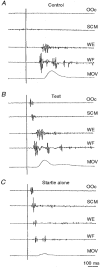Patterned ballistic movements triggered by a startle in healthy humans
- PMID: 10200438
- PMCID: PMC2269293
- DOI: 10.1111/j.1469-7793.1999.0931u.x
Patterned ballistic movements triggered by a startle in healthy humans
Abstract
1. The reaction time to a visual stimulus shortens significantly when an unexpected acoustic startle is delivered together with the 'go' signal in healthy human subjects. In this paper we have investigated the physiological mechanisms underlying this effect. If the commands for the startle and the voluntary reaction were superimposed at some level in the CNS, then we would expect to see alterations in the configuration of the voluntary response. Conversely, if the circuit activated by the startling stimulus is somehow involved in the execution of voluntary movements, then reaction time would be sped up but the configuration of the motor programme would be preserved. 2. Fourteen healthy male and female volunteers were instructed to react as fast as possible to a visual 'go' signal by flexing or extending their wrist, or rising onto tiptoe from a standing position. These movements generated consistent and characteristic patterns of EMG activation. In random trials, the 'go' signal was accompanied by a very loud acoustic stimulus. This stimulus was sufficient to produce a startle reflex when given unexpectedly on its own. 3. The startling stimulus almost halved the latency of the voluntary response but did not change the configuration of the EMG pattern in either the arm or the leg. In some subjects the reaction times were shorter than the calculated minimum time for processing of sensory information at the cerebral cortex. Most subjects reported that the very rapid responses were produced by something other than their own will. 4. We conclude that the very short reaction times were not produced by an early startle reflex adding on to a later voluntary response. This would have changed the form of the EMG pattern associated with the voluntary response. Instead, we suggest that such rapid reactions were triggered entirely by activity at subcortical levels, probably involving the startle circuit. 5. The implication is that instructions for voluntary movement can in some circumstances be stored and released from subcortical structures.
Figures



References
Publication types
MeSH terms
LinkOut - more resources
Full Text Sources

